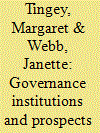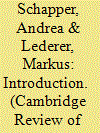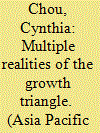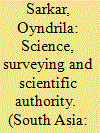|
|
|
Sort Order |
|
|
|
Items / Page
|
|
|
|
|
|
|
| Srl | Item |
| 1 |
ID:
171526


|
|
|
|
|
| Summary/Abstract |
UK Local Authorities are increasingly declaring ‘climate emergencies’ and pledging 100% clean energy and carbon neutrality ambitions for their locality, despite lack of powers over energy systems. Our research investigates current Local Authority engagement in clean energy, and considers prospects for meso-scale innovation. The analysis allocates Local Authorities to one of four categories of engagement, from energy ‘laggards’ through to ‘leaders’, based on their energy plans and investments. Findings reveal that, despite lack of direct powers, a high proportion of Local Authorities have developed sustainable energy plans and projects, but only a minority manage to combine these into a more strategic local programme. There was proportionately greater activity in Scotland and considerable variation was found across English regions. We conclude that variation in levels of engagement relates to authority size and divisions of responsibilities between different levels of government. The capacity for Local Authority-mediated social innovation to support development of a clean UK energy system is discussed. Implications for policy include the need for a statutory power, and commensurate resources, for Local Authorities, to ensure a more comprehensive and systematic contribution to clean energy innovation.
|
|
|
|
|
|
|
|
|
|
|
|
|
|
|
|
| 2 |
ID:
089379


|
|
|
|
|
| Publication |
2009.
|
| Summary/Abstract |
Burma faced independence in 1948 as a deeply divided country. The British had ruled the area, which now was declared the 'Union of Burma' under two entirely different administrative systems. 'Burma Proper' was basically populated by the ethnic Burmans, Arakanese, Mons and Delta Karens, whereas the 'Frontier Areas' were populated by the Shan people, Salween Karens, Kachins, Karennis, Chins and various subgroups of the aforementioned. The same year, as independence was granted, the Union of Burma plunged into a civil war, which still continues. This article discusses the ethnic categories created by the colonial authorities and looks into how these ethnic categories have been - and continue to be - imagined, invented, manipulated and politicised. The article looks into how the Burmese authorities dealt with the ethnic diversity in the first constitution of 1947 by dividing the country into ethnically based 'states' and 'divisions' and how the international community of today continues supporting these colonial categories.
|
|
|
|
|
|
|
|
|
|
|
|
|
|
|
|
| 3 |
ID:
137149


|
|
|
|
|
| Summary/Abstract |
This special issue contributes empirical analyses to the evolving research programme on human rights and climate change within international relations (IR) scholarship. We aim to supplement the existing normative debate within political philosophy and political theory on international, environmental and intergenerational justice (for example, Hiskes 2009; 2010; Woods 2010; Shue 2011; Arnold 2011) with empirical insights that regard human rights as a yardstick for climate-relevant action. We pay particular attention to institutionalization processes at the intersection of human rights and climate change.
|
|
|
|
|
|
|
|
|
|
|
|
|
|
|
|
| 4 |
ID:
072725


|
|
|
|
|
| Publication |
2006.
|
| Summary/Abstract |
The Singapore-Indonesia-Malaysia Growth Triangle has been applauded by the governments of the three nation states, economists and transnational corporations as an economic success. However, other stark realities are evident at the local level as well. The Growth Triangle is supplanting older cultural and economic geographies. This has given rise to struggles over rights to territories and resources. Of the three points in the triangle, it is the landscape of Riau-Indonesia that has been transformed most dramatically. A comparative study of the cadastral maps of the administrators of the Growth Triangle versus the community maps of the indigenous peoples shows the differences in their perceived spatial ideas of Riau. It also highlights the different systems of knowledge as upheld by the administrators in contrast to that of the indigenous inhabitants. This comparative study brings to attention the issues of knowledge construction, mapping knowledge and the politics of mapping.
|
|
|
|
|
|
|
|
|
|
|
|
|
|
|
|
| 5 |
ID:
154554


|
|
|
|
|
| Summary/Abstract |
This article traces the journeys of and controversies surrounding the Schlagintweit brothers in ‘India and High Asia’. The brothers were Alpine glaciologists from Germany who were invited by the East India Company in 1854 to complete the Magnetic Survey of the Indian subcontinent on the recommendation of Alexander von Humboldt. This article discusses how the Schlagintweit brothers became the subject of controversy, and how they vanished from the record of the history of surveying as abruptly as they had emerged. Their story calls into question established historiographical narratives about ‘colonial science’ and ‘Western science’ in the subcontinent.
|
|
|
|
|
|
|
|
|
|
|
|
|
|
|
|
| 6 |
ID:
072886


|
|
|
|
|
| Publication |
2006.
|
| Summary/Abstract |
The development and decay of Western thought on military planning over three centuries privileged one form of strategic thinking over another, reducing the ability of Western armed forces to deal with contemporary threats. The new military science called, by 1810, 'strategy', promised victory within a framework that privileged long-term institutional and state security. Building on anthropological, historical, and sociological insight, driven by empathy with the enemy, it eventually became possible to conceive of bloodless war.
As military and political contexts became increasingly complicated in the nineteenth century, though, theorists of strategy such as Clausewitz struggled to adapt to epistemic change. But unable to adapt to new kinds of knowledge, military institutions suppressed cultural insights required for adaptation. Instead they stressed easier-to-teach tools like mapping, anticipation of enemy movements, and rapid response.
In the 21st century the American military remains entrenched in the logic of decaying strategic thinking of the 19th century. In place of strategy, it relies on 'stratagem', emphasizing technology and surprise over long-term planning. Institutional inertia and intensive training amplify the conceptual distance in battle between the First and Third Worlds. Third World combatants are challenged to level the playing field through a return to long-term adaptation. The decay of Western strategy is therefore directly linked to the rise of violent terrorism. Only a return to classical strategy can overcome this trend.
|
|
|
|
|
|
|
|
|
|
|
|
|
|
|
|
|
|
|
|
|